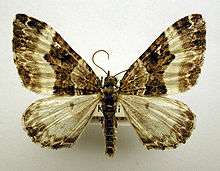Euphyia
Euphyia is a genus of moths in the family Geometridae erected by Jacob Hübner in 1825.[1][2]
| Euphyia | |
|---|---|
 | |
| Euphyia unangulata | |
| Scientific classification | |
| Kingdom: | |
| Phylum: | |
| Class: | |
| Order: | |
| Family: | |
| Subfamily: | |
| Tribe: | |
| Genus: | Euphyia Hübner, 1825 |
| Synonyms | |
| |
Species
- Euphyia adumbraria (Herrich-Schäffer, 1852)
- Euphyia biangulata (Haworth, 1809) – cloaked carpet
- Euphyia chalusata Wiltshire, 1970
- Euphyia cineraria (Butler, 1878)
- Euphyia coangulata (Prout, 1938)
- Euphyia frustata (Treitschke, 1828)
- Euphyia implicata (Guenée, 1857)
- Euphyia intermediata (Guenée, 1858) – sharp-angled carpet
- Euphyia khorassana Brandt, 1941
- Euphyia mesembrina (Rebel, 1927)
- Euphyia minima Cassino & Swett, 1922
- Euphyia scripturata (Hübner, 1799)
- Euphyia sintenisi (Staudinger, 1892)
- Euphyia swetti Cassino, 1927
- Euphyia unangulata (Haworth, 1809) – sharp-angled carpet
gollark: Shrink Windows a lot?
gollark: 512GB is enough for anyone™ and costs about, what, £60? Maybe more with ongoing supply chain implosions.
gollark: NVMe SSDs also don't cost that much more nowadays.
gollark: SSDs are also fairly cheap.
gollark: I don't believe in it.
References
- Savela, Markku. "Euphyia Hübner, [1825]". Lepidoptera and Some Other Life Forms. Retrieved May 14, 2019.
- Watson, L. & Dallwitz, M. J. (2003 onwards). "Euphyia Hübner". Insects of Britain and Ireland: The Genera of Lepidoptera-Geometridae. Version: 29 December 2011.
- Pitkin, Brian & Jenkins, Paul. "Search results Family: Geometridae". Butterflies and Moths of the World. Natural History Museum, London.
This article is issued from Wikipedia. The text is licensed under Creative Commons - Attribution - Sharealike. Additional terms may apply for the media files.